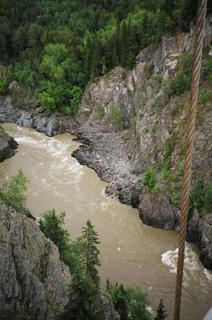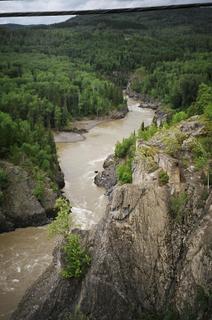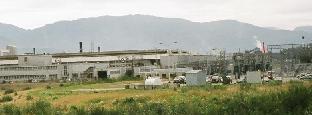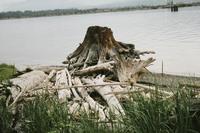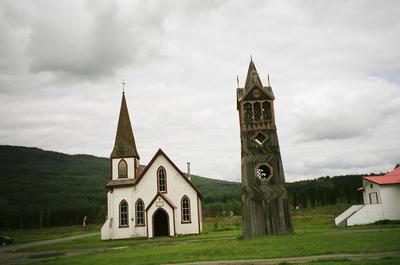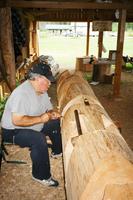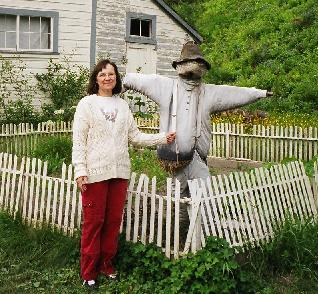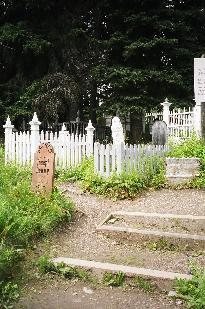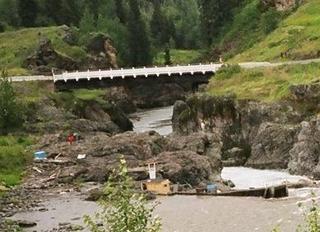
Hazelton (1)
August 1
On the drive from Smithers to Hazelton, Monday morning, I keep looking for familiar landmarks. Moricetown, is one of those. There’s a viewpoint pull-off here, so we stop to take in the majestic canyon and traditional fishing site. Sure enough, far below on this overcast Monday morning, fishermen are hard at work. With binoculars we see one of them pull a fish from a net and put it in a cooler. On the opposite shore, someone is poised at the rapids with a long spear-type thing (gaffe I think it’s called). Suddenly he plunges his gaffe into the water, but comes up empty. It reminds me of the herons fishing in our waters.
As we near Hazelton, I look for the raw cliff face I remember – but like so many things, either my memory is faulty, or the landscape has changed, for I never spot it and soon we are in the town of New Hazelton. We check into our motel, get a few groceries, have lunch, then go find the home of my former roommate Pauline.
Pauline is a nurse. She has lived in the north (with a little time spent in Nova Scotia) since she first got out of nursing school. I remember, when we shared an apartment one year in Old Town, her stories on coming back from visiting the villages as a public health nurse.
Her job has changed since then, but on talking to this lovely and compassionate lady, I see her heart is as soft as ever. She also seems sad about conditions here. Things aren’t good. Many of the lucrative jobs are gone. The wood mills have closed. Tourism is down. Lots of people have moved away. There’s much despair and suicide. Part of her job is doing assessments of elderly people to see what kind of care they need (home care, assisted living etc.). Mutterings we’ve heard in the south about government down-sizing of staff and beds (hospital and assisted living etc.) are reiterated by her. One wonders, is there ever not a gap between the idealistic cutbacks in funding (the books are balanced, there’s a plan and everything is good) and the hard reality cutbacks cause as seen by those who work in the trenches.
After a spaghetti supper with Pauline, Steve and their lively granddaughter Valerie, Ernie and I do a little exploring of the area on our own.
We drive to Old Town and I look for the apartment building in which Pauline and I used to live. Though I recognize downtown’s three corners well enough, I can’t spot our building, which was very nearby. Either it has been torn down or refaced. Another change is that the Hudson’s Bay Store has become the Northern Store. But one thing hasn't changed. John Field school, where I taught when I lived here before, is still standing and apparently going strong.

We also find St. Peter’s Anglican Church, a building that’s been in constant use since 1900. It was built by Bishop Ridley – and here is a neat thing. Leslie lent me a book (
Challenge the Wilderness), which tells of an amazing pioneer missionary to the area, Dr. Robert Tomlinson and his son Robert Jr. The Tomlinson family started a Christian village at Meanskinisht (near present Kitwanga) and part of that village was a sawmill. I just read yesterday, Bishop Ridley contracted with George Tomlinson Jr. to supply the wood for this church from that sawmill!
At Skeena Landing we see the SS Hazelton, a 90 foot paddlewheel steamer replica of the boat that used to navigate the rapids of the Skeena River to get people and supplies up to this point. Here is Robert Tomlinson Jr.’s recollection of the first trip that steamboat made down the river:
We who lived along the river never believed such a huge boat could climb up the wild Skeena, but one day while we were planting potatoes, we heard a strange, deep booming resonance echoing through the forests. We soon learned that it was the exhaust from the steamboat’s engine. In a riverboat the exhaust steam is turned into the funnel and in this way it increases the draft, but it makes a lot of noise, and this is what we were hearing. It seemed to be getting louder so we dropped our tools and ran down to the river’s edge to see what was coming.
It turned out to be still a long way off. At last there she came around the bed, the first steamboat ever to navigate the Skeena River. She stopped at our mission village for a while and then she went on....
On our way back to New Town, we stop at the Hagwilget Canyon to walk over the suspension bridge.

Views of the canyon looking down from the bridge...
